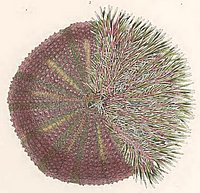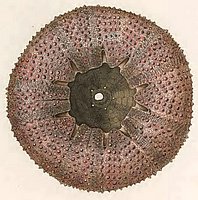Toxopneustidae
Troschel, 1872, p.38
Genre type : Toxopneustes Agassiz, 1841
Description succinte de la famille : Tubercules non perforés et non crénelés. Plaques ambulacraires composées, l'élément inférieur étant le plus développé. Scissures péristoméales très exprimées.

![]()
|
Lytechinus variegatus (Lamarck, 1816) |
|
Lytechinus variegatus (Lamarck, 1816) - Miocène, Murcia, Espagne, 37 mm |

|
Hawaiian and other Pacific Echini. The Pedinidae, Phymosomatidae, Stomopneusidae, Echinidae, Temnopleuridae, Strongylocentridae and Echinometridae, p.276 Espèce type Nudechinus scotiopremnus Clark,1912 ibid., p.276 Extension stratigraphique (bibliographique, non vérifiée) : Actuel Syn. |
|
Nudechinus, gen. nov. Type-species, Nudechinus scotiopremnus, sp. nov. The group of species to which the name of Nudechinus is given is probably the least known of any similar group of Echinidse. They are small species having in common the two characters of a thin, bare bucoal membrane and Lytechinus-like globiferous pedicellariae. That they form the connecting link between Lytechinus and Gymnechinus seems unquestionable, but I cannot follow Mortensen in putting them in the latter genus. The highly specialized abactinal system of Gymnechinus is of far greater value for limiting a natural genus than any character shown by buccal membrane or pedicellariae. Not having seen specimens of darnleyensis Woods, inconspicuous Mortensen, or Gravieri Koshler, I have selected for the type of the genus the larger of the two new species herein described, though its status is not any more satisfactorily settled than that of the other species. We have placed multicolor Yoshiwara in this genus after examining the type-specimen, which was most courteously loaned by Professor Goto of the Imperial University, Tokyo. The specimen (PI. Ill, figs. 7-5) is 14 mm. in diameter and 8 mm. high. The actinostome is large, 7 mm. across, while the abactinal system is very small, 3 mm. in diameter. There are 14 or 15 interambulacral and 17 or 18 ambulacral plates in each column. The buccal membrane is thin and except for the ten small, well-separated buccal plates, is perfectly bare. Oculars I and V reach the periproct. The globiferous pedicell arise have valves about .35 mm. long, with a very conspicuous, straight terminal tooth, .15 or .16 mm. in length. The ophicephalous pedicellarise are abundant and not peculiar. No tridentate could be found, though prolonged search was made. The coloration is slightly different from Yoshiwara's description, for we find no brown markings on the test; all such markings seem to be deep green. The spines are essentially as described by Yoshiwara, the violet bands being very distinct though not sharply defined. Kcehler's species Gravieri is very near multicolor but if the color of the spine-bands in the former is really "clear rose," the general appearance must be very different |
from multicolor. It seems that Gravieri may also be very near Lytechinus verruculatus and rufus, but if the buccal membrane is really free from calcareous matter, the resemblance is not significant. Unfortunately Kcehler does not state what the condition of the buccal membrane in Gravieri is, as regards plates, and it is only because he places the species in Gymnechinus that it is inferred the buccal membrane is thin and naked. None of the species are known from more than one or two localities, but all are from the Indo-Pacific region. So far as our present knowledge goes, the six species of Nudechinus may be distinguished from each other as follows : Primary spines not distinctly banded with violet or rose. Test green or yellowish green or light with green blotches; spines white or whitish, green or brown at the very base .......... scotiopremnus. Test and spines not as above. Secondary spines not swollen at tip; valves of tridentate pedicellarise wide, not compressed at base of blade .......... darnleyensis. Secondary spines somewhat swollen at tip; valves of tridentate pedicellariae strongly compressed in basal part of blade .......... inconspicuus. Primary spines distinctly banded with violet or rose. Test whitish blotched with deep violet; primary spines white, each with a broad band of rose-violet (K. & V. 597) .......... sticius. Test and spines not as above. Test gray greenish with some deep green spots; primaries grayish white with 2 or 3 bands of clear rose .......... Gravieri. Test variegated with white and light and dark green; primaries with 2 or 3 violet bands near tip .......... multicolor.
|
![]()
|
Gymnechinus Gravieri nov. sp.Deux échantillons ayant respectivement 12 et 13 millimètres de diamètre. La forme du lest est arrondie et assez surbaissée. La face dorsale est un peu conique dans le plus petit exemplaire et aplatie dans le [dus grand: la lace ventrale est plane. Les aires ambulacraires , assez larges, sont très légèrement saillantes. Les ares de pores sont séparés par un petit granule secondaire, et ces granules secondaires forment une rangée régulière en dehors de la série principale. On observe, dans chaque aire, une série régulière principale de tubercules primaires: en dedans de chaque tubercule, et à la même hauteur que lui. se trouve un tubercule secondaire; entre ces deux rangées, il existe 1111e rangée de tubercules plus petits que les secondaires et alternant avec eux. Les aires inlerambulacraires sont larges. Elles offrent, à l'ambitus, trois rangées de tubercules primaires dont la médiane s’éend jusqu’au péi- procte; l’interne 11e s’éèe guèe au dessus de l’am- bitus et l’externe se prolonge un peu plus haut, de telle sorte qu’un peu au-dessus de l’ambitus, le milieu des aires inlerambulacraires n’offre que des tubercules secondaires; ceux-ci sont assez serré. La membrane péislomienne, un peu enfoncé, offre une couronne de péicellaires opliicéhales peu nombreux. Fig. 1. Périprocte et appareil apical de Gymnechinus Gravieri, grossi environ dix fois Le périprocte (ftg. 1) est excentrique, mais moins que chez les Gymnechinus Robillardi, pulchellus, etc., et la différence de taille entre les plaques génitales antérieures et postérieures est aussi moins marquée. La plaque madréporique est très développée et elle ne porte pas de granules ; les autres plaques, qui portent un ou deux granules, sont presque de mêmes dimensions. Le pore génital est très rapproché de l'angle |
externe. Les plaques ocellaires sont polites et elles ne touchent pas le périprocte, excepté la postérieure droite qui est un peu plus grande que les autres: elles portent chacune uii granule. Le périprocte est occupé par des plaques inégales et l'anus est situé à une certaine distance dn hord postérieur. Les piquants sont courts et ils ne dépassent pas a millimètres; ils sont striés. Leur couleur est blanc grisâtre avec deux ou trois bandes d'un rose clair. Les pédicellaires ophicéphales, très nombreux, ne présentent pas de caractères particuliers. Les pédicellaires globulaires renferment des spicules recourbés et épaissis vers l’extréitérappelant ceux des G. pulchellus et Robillardi; ils portent des glandes sur la lige. Je n’ai pas pu trouver de péicellaires tridactyles.La couleur du test déouillédes piquants est gris-verdâtre avec des taches vert-foncé Rapports et différences. — Le Gymnechinus Gravieri se distingue facilement des autres espèces à périprocte excentrique par la constitution de l'appareil apical avec une plaque ocellaire seulement conliguë au périprocte et par la couleur du test et des piquants.
|
|
Nudechinus gravieri (Koehler,1905) - Actuel, Mer Rouge, Egypte, 17 mm |
|
Nudechinus gravieri (Koehler,1905) - Pléistocène supérieur, chantier 10km S. Hurghada, Egypte, 9 mm |
![]()
|
Nudechinus scotiopremnus, sp. nov. Plate 97, figs. 4-6. The type-specimen (PI. 97, fig. 4) is 17 mm. in diameter and 10 mm. high; the actinostome is 7 mm. in diameter while the abactinal system is only 3.5 mm. and the periproct 1.5 mm. There are 18 interambulacral plates in each column and 22 ambulacrals. The primary spines are about 3.5 mm. long at the ambitus. In the largest specimen, the diameter is 21 mm., the height 13 mm., the actinostome 10 mm., the abactinal system 4.5 mm., the periproct, 2 mm., and the primary spines about 4 mm. ; there are 18 interambulacral, and 23 ambulacral plates in each column. In the smallest specimen, the figures are, 13 mm. h. d. 9 mm. v. d.; 6 mm. actinostome, 3 mm. abactinal system; 1.33 mm. periproct; 2.5 mm., primary spines; 14 interambulacrals ; 17 ambulacrals. The test is well arched with a circular, or in the largest specimen somewhat pentagonal ambitus. It is very completely covered with tubercles, but in the type and in the large specimen, a sunken zigzag line is more or less marked in the abactinal part of both the ambulacral and interambulacral areas. Seen from above, the small specimen and the type show distinctly, twenty radiating series of primary tubercles, two series in each area; these are of approximately equal size and are decidedly larger than the numerous accompanying secondaries. In the large specimen these twenty series are much less conspicuous as some of the secondaries particularly at and near the ambitus are almost as large as the primaries. Each ambulacral plate at the ambitus carries a primary tubercle, a large secondary near the inner end of the plate and three to five small secondaries. Each interambulacral plate has a large secondary tubercle on each side of the median primary and there are four to six small secondaries also. Scattered miliary tubercles occur in both areas. The abactinal system (PI. 97, fig. 6) is noticeably small and the periproct is covered by few plates. The madreporic genital is decidedly swollen and larger than the others; in the largest specimen it has a single tubercle on the proximal margin but in the other specimens it has none. Each of the other genitals carries two to four large tubercles. The oculars are rather small, each with a large tubercle. In the type they are all exsert, though I is only slightly so, and V is more nearly insert than any of the other three. The same condition is found in the small specimen, but in the large one, I is broadly insert and V is only barely excluded. The poriferous areas are broad, the rather large pores being arranged in quite oblique arcs of three pairs ; at the peristome the areas are narrower and the arcs are more nearly vertical. The actinostome (PI. 97, fig. 5) is large, twice the diameter of the abactinal system. The buccal membrane is thin and perfectly bare, except for the small primordial ambulacrals. The gill-cuts are very well marked and are moderately deep and wide. The primary spines are short, rather stout, blunt, and not very conspicuous. The pedicellariae are fairly common but are not peculiar. The globiferous have valves about .25 mm. long, the narrow tubular blade about as long as the rather wide base, and terminating in a single long tooth. The ophicephalous have valves of nearly the same length, with the loop adding about a third as much more. The tridentate are chiefly actinal |
in position and have valves, half a millimeter long, more or less; these valves are somewhat curved, compressed at the base of the blade and somewhat expanded distally, where they are in contact with each other. The triphyllous are very small, the valves measuring only .10 mm. in length, the width of the blade being a trifle less. No calcareous spicules were found. The color of the three specimens displays some diversity. The smallest has a light gray test, with a few scattered greenish blotches abactinally; the spines are white, dark brown at the very base. The type is greenish yellow with the primary spines whitish, dull green at the very base. The large specimen is yellowish green with the primaries whitish, deep green at the very base. The type and the small specimen are labelled " de Suez, Vaillant. Psammechinus de Liitken." They were obtained in Paris in 1869 by Mr. Agassiz, but were never identified by him. The large specimen was purchased in Hamburg in 1870 by Mr. Agassiz and bears the label "New Zealand." It is probable that one, if not both, of these locality labels is erroneous and as the latter appears to be the less reliable of the two, the Indian and East African coasts will possibly prove to be the home of this species. It seems to be nearly related to inconspicuus Mortensen but is easily distinguished by the genital plates, the tuberculation and the coloration. The pedicellarise are remarkably similar to those of inconspicuus. planche 97 (extrait)
|
|
Nudechinus scotiopremnus Clark,1912 - Pléistocène supérieur, chantier 10km S. Hurghada, Egypte, 14 mm |

![]()
|
Echinus Duciei Test circular, much depressed : ambulacral areas more than half the width of the interambulacral, with two rows of marginal nearly equal-sized tubercles throughout, and two other rows within these, extending from the border to the mouth ; one of these inner rows ascends a short way above the border : interambulacral areas with eight rows of tubercles at the border, diminishing to two rows above the others, disappearing or becoming of secondary size ; from the border to the mouth, the eight rows continue of uniform size : the pores are in triple oblique pairs ; between each pair there is a slight ridge of the test, which gives a singular zigzag figure to the poriferous avenues : mouth large and decagonal, base flat : apical disc of moderate size, but not preserved. Dimensions. - Height 15/20 of an inch ; transverse diameter 1 17/20 inch. Description. - This beautiful Urchin has been thought to be identical with the E. Scillae, Desmoul., and the one figured by Scilla in pl. 13. fig. 1, pl. 25. fig. 1, and pl. 26. fig. A, B, of his work* ; but the number of tubercles on each of the plates in our specimen differs from the Echinus è Messana of that author, who has figured only one large tubercle on each plate of that form. From E. Scillae it is certainly distinct, as we know of no Urchin that is common to the cretaceous and tertiary rocks. The test is circular, much depressed on the upper surface and flat below ; the ambulacral areas are almost 4/10ths of an inch in width at the border, where we count four rows of tubercles ; the marginal rows are very univorm in size and arrangement from the mouth to the disc ; the two internal rows are smaller, and continue from the border to the mouth ; one of these extends a short distance on the sides, but on the upper half of the areas there are only the two marginal rows : the interambulacral areas are 7/10ths of an inch in width at the border ; there are eight rows of tubercles at this point and onwards towards the base, they are nearly of the same size ; but, from the border to the apical disc, the second row, from the ambulacral areas, alone possesses the size the tubercles have at the border ; the bubercles in the others diminish in size, and disappear as the areas become narrower ; above, we find only two marginal tubercles of the primary size, and internal to theses, a few of secondary magnitude irregularly set : all the tubercles are raised on mammillary eminences, with areolas around their bases, and numerous large granules |
fill up all the intervening spaces, so that the surface of this Echinus has a very tuberculatd appearance. The poriferous avenues are on a level with the test ; the pores are arranged in triple oblique pairs ; between each pair there is a slight elevated ridge ; every two ridges of each triple oblique pair of holes is connected by another ridge, which runs at an angle of 45° to them ; by this arrangement the poriferous avenues exhibit a curious zigzag character through these little elevations of the test in the line of the pedal pores. The base is flattened, the mouth-opening is large and decagonal, and the jaws and teeth are narrow and much curved inwards ; the apical disc is absent in all the spedimens we have examined ; the space for the same is, however, of moderate size. Affinities and differences. - This species may be distinguished from Echinus Serresii, Desmoul., from the Molasse de Provence, in having larger tubercles, with less granulation at their base, and the absence of the zigzag ridges between the pairs of pores : from Echinus dubius, Agass., another tertiary species from the Molasse of Villeneuve in Provence, it is distinguished by the more uniform size of its tubercles, the depression of the upper surface, and the zigzag ridges of the poriferous zones. Locality and stratigraphical range. - It was collected from bed No. 1, the Gozo marble, Malta, where it is not uncommon. We have dedicated this species to the Earl Ducie, who collected the beauticul specimens we have figured. * De Corporibus Marinis Lapidescentibus Extrait de la planche IV |
|
http://coldb.mnhn.fr/catalognumber/mnhn/f/r62134 spécimen MNHN.F.R62134 crédit RECOLNAT (ANR-11-INBS004) Jocelyn FALCONNET Cottreau, p. 83 pl. 1 fig. 15 text-fig. 14 |
||
|
|
 |
|
http://coldb.mnhn.fr/catalognumber/mnhn/f/r06854 spécimen MNHN.F.R06854 crédit RECOLNAT (ANR-11-INBS004) Jocelyn FALCONNET Roman, p.97, pl.A, fig.6 |
||
|
|
 |
|
Schizechinus duciei (Wright, 1855) - Miocène, Murcia, Espagne, 37 mm |
![]()
|
anapesus saheliensis C. Pl. III, fig. 1 à 7. Schizechinus saheliensis Pomel olim. Diamètre, 0m053 ; hauteur, 0m027. Oursin de taille médiocre, à pourtour circulaire convexe en dessus, tronqué pulviné en dessous (tous nos exemplaires sont déformés par compression). Zones porifères un peu déclives sur les côtés de l'ambulacre légèrement en relief. Zygopores obliquement échelonnés par trois, séparés par une costule portant çà et là de très petits granules, la paire inférieure semblant s'appuyer sur un granule mamelonné qui, à l'ambitus, devient un vrai tubercule seulement un peu plus petit que les secondaires de l'ambulacre et forme une rangée qui ordinairement appartient à l'interambulacre. Ambulacres pourvus de deux rangées de tubercules rapprochés, bien saillants, entre lesquelles s'en trouvent deux autres secondaires, un peu irrégulières, s'effaçant bien avant d'atteindre le pôle et remplacées par de simples granules. Interambulacres non dénudés dans le haut, portant deux rangées principales de tubercules un peu plus gros et plus espacé que les ambulacraires, flanquées d'une rangée externe et d'une interne ne remontant pas au sommet, presque aussi développées en grosseur et d'une autre encore plus courte le long de la suture dans les sujets plus âgés. Il en résulte des séries presque homogènes, transverses de quatre ou de trois sur chaque zone ; ces tubercules bien séparés sont encadrés par de petits granules scrobiculaires, dont un plus fort, bien saillant, est sous la suture entre les rangées verticales;. Radioles courts, 7mm sur 1, à couronne finement crénelée, à tige subaciculée finement cannelée. |
Péristome subdécagonal à lèvres inégales, les ambulacraires un peu arrondies, les interambulacraires tronquées, séparées par des scissures obliques bien marquées mais peu profondes et bordées. Périprocte inconnu. Cette espèce a quelque affinité avec C. alternans dans la constitution de ses zones porifères et de ses ambulacres, mais les rangées secondaires de tubercules y sont plus ou moins complètement doubles, et les tubercules du dessus sont plus homogènes dans leur ensemble, moins rapprochés dans chaque rangée. Terrain sahélien : zone à spicules et bryozoaires du ravin d'Oran. Extrait de la planche C.III |
|
|
http://coldb.mnhn.fr/catalognumber/mnhn/f/r62110 spécimen MNHN.F.R62110 crédit RECOLNAT (ANR-11-INBS-0004) Peter MASSICARD Roman & Lachkhem, p. 453 pl. 1 fig. 15 |
|
|
|
|
Schizechinus saheliensis (Pomel, 1887) - Pliocène inférieur, Almeria, Espagne, 57 mm |
![]()
|
anapesus serialis C. Pl. IV, fig. 1 à 7. Schizechinus serialis Pomel olim.
Oursin globuleux subhémisphérique, convexe en dessus, tronqué arrondi, pulviné en dessous et assez déprimé autour du péristome, à pourtour régulièrement circulaire. Apex inconnu. Zones porifères étroites, non élargies vers la base, presque à fleur, chaque échelon de trois zygopores séparé de ses voisins par deux petits tubercules, le plus petit touchant au tubercule primaire, le plus gros contigu à l'interambulacre. Ambulacre à peine saillant, portant deux rangées primaires de tubercules bien mamelonnés, flanquées du côté interne d'une rangée d'autres tubercules presque aussi gros, mais s'effaçant avant les extrémités des zones ; la bande médiane, lorsqu'elle s'élargit, occupée par une cinquième rangée encore plus courte, appartenant à l'une ou à l'autre des demi-aires. Tubercules interambulacraires peu volumineux, presque homogènes, en nombreuses rangées régulières, la principale de chaque zone s'étendant d'un pôle à l'autre, flanquée du côté interne de trois autres de longueur inégale, la plus courte vers la suture, mais de volume peu différent ; du côté externe sont deux autres rangées, la plus courte contre la zone porifère, formées de tubercules un peu plus petits, plus nombreux et ne continuant pas les séries transverses des autres quatre rangées. Des granules le long des sutures horizontales et quelques rugosités en travers tracent imparfaitement l'encadrement des scrobicules. |
Péristome ayant environ les 29/100 du diamètre, arrondi, sub-décagonal, à lèvres ambulacraires arrondies et émarginées, plus larges que les interambulacraires tronquées en arc, séparées par des scissures très développées, étroites, bordées d'une aile calleuse tordue en cornet. Périprocte inconnu. La grande taille de cette espèce et ses tubercules nombreux sub-homogènes, ne laissant aucun surface dénudée, la distinguent de la plupart de ses congénères. A. Marii qui a aussi de nombreuses rangées de tubercules, en diffère par ses rangées secondaires montant moins haut et surtout par sa forme resserrée conoïde vers le haut. Terrain pliocène : molasses du Sahel d'Alger et de l'Oued Knis : couches coquillères de Douéra ; col de Sidi Moussa, au pied du Chenoua. Extrait de la planche C.IV |
|
Schizechinus serialis (Pomel,1887) - Pliocène, Carboneras, Murcia, Almeria, Espagne, 73 mm |
|
Schizechinus serialis (Pomel,1887) - Pliocène, Almeria, Espagne, 53 mm |
|
|
|
|

|
Toxopneustes.
In spite of the fact, referred to on p. 245, that Toxopneustes elegans Dod. forms a connecting link with Lytechinus, this is a very natural and easily recognized group. The broad poriferous areas, the short primaries, the abundant tubercles, and the deep gill-slits combined with the absence, on many ambulacral plates, of primary tubercles adjoining the poriferous area, give the members of the genus an easily recognized appearance. Indeed the characters of the test are so uniform, that the most obvious and perhaps the best specific characters are found in the coloration. The difference in tuberculation between roseus and pileolus, to which Mortensen refers ("Ingolf" Ech., pt. 1, p. 112) is not constant, and some specimens of pileolus from Japan cannot be distinguished in this respect from roseus. Since color seems to be the best criterion in this genus for determin ing specific limits, Mortensen's restoration of roseus A. Ag. as a valid species may be accepted and a form (chloracanthus) , of which several specimens of very distinctive coloration from Samoa are in the M. C. Z. collection, is here described as new. The most wide-ranging species is pileolus, which extends from Mauritius to New Caledonia and Japan, and perhaps even to the Hawaiian Islands. The little known and apparently rare species maculatus Lamk. is from Bourbon and Christmas Island, Pacific Ocean, which indicates as wide a range practically, as that of pileolus. The American species roseus seems to be isolated on the west coast of Mexico and Central America, while elegans is known only from Japan. |
Histoire naturelle des animaux sans vertèbres présentant les caractéres généraux et particuliers de ces animaux, leur distribution, leurs classes, leurs familles, leurs genres, et la citation des principales espèces qui s'y rapportent, p.45
|
7. Oursin calotte. Echinus pileolus. Ech. orbicularis, convexus ; subtùus concavus, rubro et viridi albescente variegatus ; fasciis seporis ; seriebus obliquatis ; spinis brevibus. Mus. n.° Habite les côtes de l'Ile-de-France. M. Mathieu. |
|
Toxopneustes chloracanthus, sp.
nov.
The four specimens on
which this species is based were received by the Museum of Comparative
Zoology from the Godeffroy Museum in 1870, and are labelled "Samoa."
The largest is 106 mm. in diameter and 56 mm. high while the smallest
is only 40 mm. h. d. The latter and the next to the largest have the
green markings very deep and well defined. It is quite possible that
this species will prove to have the same relation to typical pileolus
that the Florida form of Lytechinus variegatus has to the
typical form of that species, and if such proves to be the case, then
chloracanthus should rank only as a subspecies. In the absence of
connecting forms however it is preferable to give it full specific
rank. The occurrence of this green form of Toxopneustes at
Samoa is interesting in connection with the existence of a well-marked
green variety of Mespilia among the same islands (see p. 322).
The latter however seems to occur with the usual form, while so far as
known typical pileolus does not occur at Samoa.
planche 93 (extrait) |
|
Toxopneustes pileolus (Lamarck,1816) - Actuel, Philippines. Olango Island. Cebu, plongée, 20 m, 108 mm |
|
Toxopneustes pileolus (Lamarck,1816) - Actuel, Philippines. Olango Island. Cebu, plongée, 20 m, 118 mm |


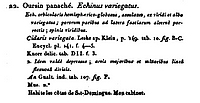
,%20ambital,%20Pliocene,%20Tamiami%20formation,%20Charlotte%20county,%20Floride,%20USA,%2033%20mm.jpg)
,%20oral,%20Pleistocene%20sup,%20Baustellen,%2010km%20S%20Hurghada,%20Egypte.jpg)
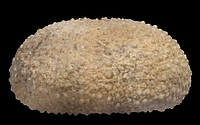
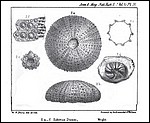
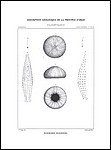

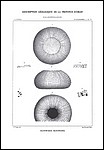
,%20amb,%20Pliocene,%20Carboneras,%20Murcia,%20Almeria,%20Espagne,%2073%20mm.jpg)
